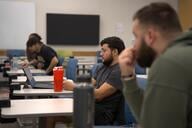You have /5 articles left.
Sign up for a free account or log in.

UTSA convenes student success executives each week to discuss data and institutional strategies.
courtneyk/E+/Getty Images
Walking into Ruby Tuesday at UTSA, one can expect to be served vegetables and desserts in the form of data sets, dashboards and tough-to-answer questions.
The University of Texas at San Antonio established a regular Tuesday afternoon meeting among student success shareholders in 2018 to address issues of retention, completion and equity across the institution, which team members nicknamed “Ruby Tuesday.”
The meetings help build a culture of data-minded thinking and ensure consistency and accountability in strategic prioritization.
The background: Ruby Tuesday was established to help break administrative silos in student success work. The name came from the initial recurring meeting day.
“Success is not the responsibility of just one office or division; it’s in our culture, it’s in our DNA,” Tammy Wyatt, vice provost for student success at the University of Texas at San Antonio, said at a July 18 webinar by the American Association of Colleges and Universities. “It’s the duty of the entire institution. And so to live this wisdom, we needed to implement an organizational structure and some operational practices that would reinforce student success as a key initiative.”
Nicknaming a standing meeting is not uncommon at UTSA, either—the all-college deans’ meeting on Mondays is 3M, short for Merry Monday Meeting.
How it works: Ruby Tuesday is subgroup of the Academic Council, which is the core academic affairs leadership team, involving the college deans and vice provosts. With Ruby Tuesday, all academic support unit executive leaders meet, including student success, institutional research, strategic enrollment, academic innovation, undergraduate studies, graduate studies and student affairs. The group is regularly evaluated to incorporate new members based on the university’s priorities.
During the 90-minute Tuesday meetings, the team reviews data, prioritizes strategies and works to tackle any unanswered questions. Steve Wilkerson, associate vice president and chief analytics officer at UTSA, and his team provide the data for the stakeholders to discuss.
One of the benefits of the meetings is having dedicated time to convene around shared problems.
“We have 30,000-foot [conversations] all the way to in-the-weeds conversations and strategize for how to best support our students,” Wyatt said in the webinar.
The data review is framed either as “vegetables or desserts,” as team members evaluate enrollment numbers, admission funnels or other data sets. Areas of progress, or the desserts, are celebrated, and the vegetables, or ongoing challenges, are chewed on.
Team members make every effort to attend these meetings, even when traveling for conferences or other university matters. Ruby Tuesday members also have built camaraderie over the years, which adds to their effectiveness.
The impact: Over the years, the Ruby Tuesday team created a multiyear plan to assess various programs and services, focusing on one office at a time, looking at each program’s data. Projects are prioritized by the number of students impacted by the change, ensuring that efforts reach as broadly as possible.
In the review of tutoring services, staff used propensity score matching (comparing students with similar demographic characteristics who had used tutoring to those who hadn’t) to understand how outreach and strategy could be validated and revised.
The results showed that male students were less likely to engage but could improve their academic outcomes if they utilized services, allowing staff to change the types of communication and engage other campus stakeholders, such as faculty members, in the work.
Another project was building caseload management for student success coaching. Previously, many of the students utilizing success coaching were graduate or honor students who weren’t the learners who could stand to benefit the most from individualized academic support. Using data, Ruby Tuesday team members helped guide success coaches to focus outreach on students with higher needs who could see larger gains in their academic standings and build a peer-coaching model for high-performing learners instead.
In a recent pilot, UTSA hired four graduate students to call and check in on students who were disengaged (identified by those with low midterm grades and who hadn’t logged in to their learning management system for over two weeks). The student employee called to check in on learners and ask how they were doing and offered help, which students responded positively to.
“They’re like, ‘Wow! The university is calling me and they’re not asking for money. They’re asking if I’m OK,’” Wyatt said.
Other project outcomes include building dashboards that allow for disaggregation by demographic, establishing an institutional survey policy (which standardizes how surveys are conducted), creating undergraduate curriculum mapping and revising new program planning processes.
DIY: For another institution looking to model the initiative, staff offer some insights:
- Buy-in is necessary. From top leadership down to individual departments, this approach requires all stakeholders to be on board to integrate these practices into existing structures and routines.
- Be data informed. Having data is one thing, being able to read it, know what the data says and make actionable insights is another.
- Nothing is one-size-fits-all. Strategies should be tailored to the institution’s specific needs and evaluated on insights to find best practices.
- Monitor progress. Stakeholders need to be equipped with actionable data to refine processes, helping build to the next level of success. In the same vein, progress takes time, so celebrating small wins and building momentum helps.
- Be innovative. “You have to be able to accept failure and give people the space to feel comfortable that we’re going to try something and not everything that we try is going to work,” Wilkerson said during the webinar. “You take that as a learning opportunity to go ahead and improve and find something that does [work].”
How does your institution use data to inform decision-making? Tell us here.



